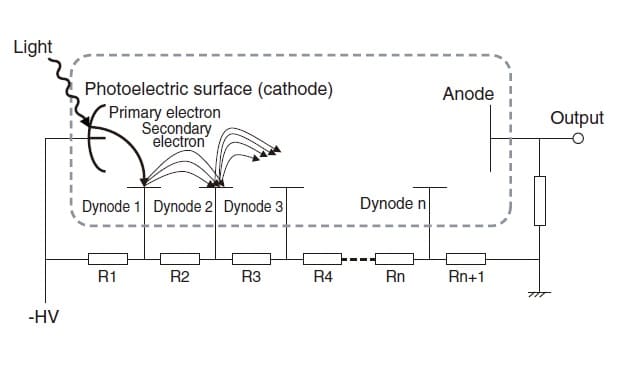How does a photomultiplier tube work?

PMT’s function via the photoelectric effect. In the photoelectric effect, electrons are emitted from certain types of metals as a consequence of their absorption of a photon of light energy, such as visible or ultraviolet light (at left). PMT’s function by a photon striking the first dynode, which releases electrons into a dynode chain with progressively higher voltages. This causes an electron cascade down the dynode chain until the electrons hit the anode which generates the electrical charge that can be measured. The net result is one photon releases many electrons onto the anode (see picture above). PMT detectors multiply the current produced by incident light by as much as 100 million times (i.e., 160 dB), in multiple dynode stages, enabling, for example, individual photons to be detected even when the incident light flux is very low.
A photomultiplier tube utilizes the external photoelectric effect, the phenomenon whereby photoelectrons are discharged when light strikes a photoelectric surface. This slide illustrates the operating principle of a photomultiplier tube. Photoelectrons discharged from a photoelectric surface (i.e., primary electrons) cause the successive emission of secondary electrons from dynodes (electron-multiplier electrodes) arranged in multiple stages, and this cascade ultimately reaches an anode. If one primary electron causes the emission of δ secondary electrons, and this process is repeated n times, then a multiplication factor of δn is obtained. Because photomultiplier tubes ultimately produce a large output for a low level of light intensity, their most important feature is that they offer an outstanding level of sensitivity, which cannot be obtained with other optical sensors. δ is referred to as the "secondary emission coefficient." A high voltage (-HV) is applied from outside the tube in order to accelerate the electrons.
The higher the value of this voltage, the larger the secondary emission coefficient. Another feature of a photomultiplier tube, then, is that the multiplication factor can be adjusted by controlling this high voltage. If there is sufficient light intensity, the voltage is decreased. If the light intensity decreases, the voltage is increased. If the slit is changed, or if accessories that cause significant decreases in light intensity, such as integrating spheres, are used, the advantages offered by this photomultiplier tube become particularly important. For this reason, photomultiplier tubes are used in high-grade instruments.


